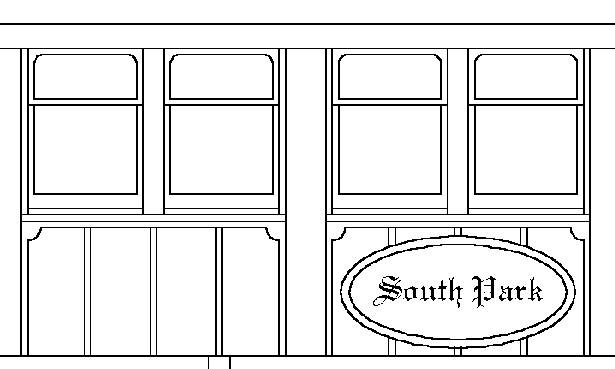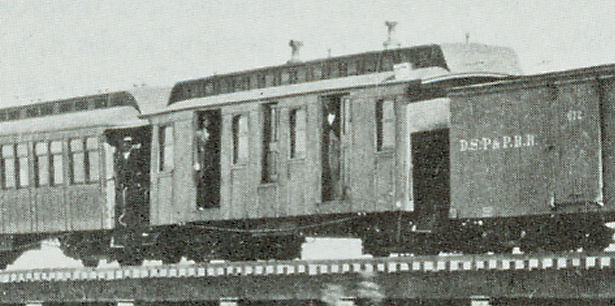Pullmans Bonanza, Leadville, San Juan
|
| “The Pullman Company has just supplied the Denver South Park & Pacific with four very elegant and comfortable narrow gauge Pullman Palace Cars. They are now running. The Pullman Company owns the cars, which were built at the Detroit works, and furnishes and maintains them on a contract similar to that made with other railroads through the country. The cars, which are appropriately named, ‘South Park’, ‘Leadville’, ‘San Juan’, and ‘Bonanza’, each contain ten sections -- upper and lower berths -- and can thus accommodate twenty passengers. They are 42 feet long, 8 feet 4 inches wide, and 8 feet high inside, and weigh 15 tons. They run on 30 inch paper wheels with the Pullman standard truck reduced. Externally they are painted in the rich dark color adopted as the Pullman standard, ornamented in gold after the Eastlake syle. The interiors are beautifully finished. The ceilings (which are of wood) are sides are finished in Marquetrie, with mahogany, burl, prima vera (white wood), amaranth, ebony, and rosewood. The seats, seat covers, curtains, mattresses, and other appurtenances are up to the degree of excellence for which this company is famed. The windows are large -- nearly equal to those in the standard car. Eames vacuum brake attachments, Baker heaters, and Hicks and Smith’s improved lamps, and various minor conveniences are included. In short, these cars, both in appearance and in actual comfort for the traveler, are very similar to the full sized Pullman sleepers, and their workings are perfectly satisfactory.” |
Bonanza, Leadville and San Juan all had double pane windows with only the tiniest rounding of the upper pane. They had not true board-and-batten siding, but a very distinctive type of paneling (see below). The platform roofs had the bullnose profile which seems to have been typical of Pullman-built cars. Their wheels were unusually large for narrow gauge cars, being 30" in diameter (compared to the usual 24" or 26") and were of a new type called “paper wheels.”
 |
|
Illustration of paneling on sides of all four “plan 73” Pullman Palace sleeping cars. Paneling would generally be ½" to ¾" thick with decorative "battens" 3/8" to ½" thick. It was prone to cup and check no matter how many coats of varnish it got, especially in the temperature extremes of the Colorado mountains. Unfortunately, since the next photos we have of these cars are as much as 15 years later, we can't say how long it lasted before being replaced with the more utilitarian beaded tongue-and-grove "railroad" siding. Actually, from the look of those photographs, the original paneling below the windows was more than likely overlaid by the new siding. |
Bonanza,
Leadville
and
San Juan
were no doubt painted Pullman’s standard color of the time:
described in 1877 as a “maroon”, and in 1884 by the railroad trade press as
“a dark plum.” They were decorated in the “Eastlake” style, a simpler style
than previously used, with ornamentation provided by patterns incised into
the wood or created by contrasting colors rather than the voluptuous
carvings of prior years.
HISTORY
Pullman Palace Cars Bonanza, Leadville and San Juan were assigned to the South Park in November 1879 by the Pullmans Palace Car Company. They were three of four cars built in October and November of that year as Pullman’s lot #61 for service on the Denver, South Park & Pacific. The fourth car in lot #61 was the South Park. All were built to Pullman plan 73, which was modified a year later and apparently used thereafter only in the modified form.
Bonanza, Leadville, San Juan and South Park were probably used more-or-less as parlor cars until the South Park began regular daily service to Leadville eight months later (June 1880), and possibly even after. These cars were not owned by the South Park, but were operated under contract with the Pullmans Palace Car Company (see The Pullman Sleeping Cars page for details).
Poor {44} tells us that the Gunnison Review for 19 March 1881 reported a train wreck involving a sleeper.
|
“At 3:30 this morning a South Park train of sleeper, coach and baggage cars met with a serious accident near Thompson, 46 miles from Denver. The rear trucks [sic] of the sleeper jumped the tracks dragging the other two cars off the track, but leaving the locomotive on the rails. The sleeper turned a somersault down down the bank, some 30 feet into the Platte River, where water soon filled the car to a depth of 12 to 18 inches. The passengers escaped by crawling through windows. Of the 26 that were on the train, two were seriously injured. The railroad soon secured a box car and continued on their way into Denver.” |
There is nothing here to indicate this was the San Juan, other than the fact that the San Juan burned six months later (September 1881) while in the Denver shops. Take it for what it’s worth.
We have no information as to which of the remaining cars was operated on what routes, but apparently there was enough traffic that just before sleeper service was inaugurated between Denver and Gunnison the next year (October 1882), two more sleepers had to be assigned by Pullman (one apparently to replace the San Juan).
The sleeping car business was lucrative, and Pullman was making most of the money, so many of the railroads forced Pullman to form “associations" that gave them a share of the profits. The Union Pacific did this in May 1884, and ownership of Bonanza, Leadville, San Juan and South Park passed to the Pullman-Union Pacific Association. Thus none were either numbered or renumbered by the Union Pacific in 1885.
In July 1887, sleeper service to Gunnison was discontinued, and in November all sleeper service on the Gunnison Division was discontinued (sleepers had been running as far as St, Elmo). In January, the two newer sleepers were withdrawn from the Association to be rebuilt for service elsewhere.
